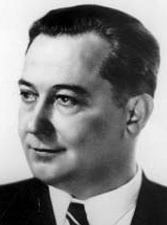Loading AI tools
Yugoslav Croat politician From Wikipedia, the free encyclopedia
Ivan Šubašić (7 May 1892 – 22 March 1955) was a Croat politician, best known as the last Ban of Croatia and Prime Minister of the royalist Yugoslav Government in exile during the Second World War.[1][2]
Ivan Šubašić | |
|---|---|
 | |
| Minister of Foreign Affairs | |
| In office 1 June 1944 – 17 October 1945 | |
| Monarch | Peter II |
| President | Josip Broz Tito |
| Prime Minister | Josip Broz Tito |
| Preceded by | Božidar Purić |
| Succeeded by | Josip Smodlaka |
| 18th Prime Minister of Yugoslavia | |
| In office 8 July 1944 – 2 November 1944 | |
| Monarch | Peter II |
| Preceded by | Božidar Purić |
| Succeeded by | Josip Broz Tito |
| Ban of the Croatian Banovina | |
| In office 24 August 1939 – 1941 | |
| Deputy | Ivo Krbek |
| Preceded by | Position established |
| Succeeded by | Position abolished |
| Personal details | |
| Born | 7 May 1892 Vukova Gorica, Croatia-Slavonia, Austria-Hungary (now Croatia) |
| Died | 22 March 1955 (aged 62) Zagreb, PR Croatia, Yugoslavia (now Croatia) |
| Nationality | Yugoslav |
| Political party | Croatian Peasant Party (HSS) |
| Awards | Order of the White Eagle |
Ivan Šubašić was born in Vukova Gorica, a village along the Karlovac-Rijeka highway in Karlovac district, Croatia. He completed the first grades of elementary school in the neighboring Prilišće and his secondary education in Zagreb. His studies at the Faculty of Theology (the University of Zagreb ) were cut short, as he was drafted into the Austro-Hungarian Army. Captured on the Eastern Front, he subsequently joined the Yugoslav volunteers fighting at the Salonica.
Once the war was over, Šubašić obtained his law degree at the Faculty of Law, University of Zagreb and opened his first law office in Vrbovsko, close to his birth place. After meeting Vladko Maček, he joined the Croatian Peasant Party and was elected to the Yugoslav National Assembly in 1938.

In August 1939, Maček and Yugoslav Prime Minister Dragiša Cvetković reached the deal about the constitutional reconstruction of Yugoslavia and restoration of Croatian statehood in the form of Banovina of Croatia—an autonomous entity which, together with Croatia proper, included large sections of today's Bosnia and Herzegovina and some sections of today's Vojvodina, which contained an ethnic Croat majority. Šubašić was appointed as the first ban, or titular head of this entity, in charge of its government.
The Banovina came to an end together with Kingdom of Yugoslavia, following the invasion by Axis powers in April 1941. Šubašić joined the Yugoslav government-in-exile.
In emigration, Šubašić first represented the Yugoslav royal government in the United States. As NDH atrocities became public knowledge, he actively spoke on behalf of the Croatian people, as Konstantin Fotić, then a Yugoslav ambassador to the US used his position to portray the entire nation as murderous fascists. Gradually, the widening gap between the royalist government and Yugoslav major resistance movement embodied in Josip Broz Tito and his Communist-dominated Partisans forced Winston Churchill to mediate. Šubašić, a non-Communist Croat and a voice of reason was appointed as the new prime minister[3] in order to reach a compromise between Tito—whose forces represented the de facto government on liberated territories—and the monarchy, which preferred Draža Mihailović and his Serb-dominated Chetniks.
Šubašić met with Tito on the island of Vis and negotiated the Tito–Šubašić agreement, which recognised the Partisans as the legitimate armed forces of Yugoslavia in exchange for Partisans formally recognising the new Royal government. Šubašić kept his post until 2 November 1944, when Tito formally became the new prime minister of Yugoslavia. Šubašić served as a foreign minister in his cabinet until October 1945. Finding out about the scope of mass murders of Croatian civilians and realizing there would be no democracy in the new Yugoslavia, he suffered a stroke and left politics for good, saying "he would not be a lid to the bloody pot" of the country.
Šubašić spent the remainder of his life away from the spotlight, closely followed by UDBA agents and dying in Zagreb in 1955 . About 10,000 people attended his funeral.[4] He is buried in Mirogoj Cemetery.[5]
Seamless Wikipedia browsing. On steroids.
Every time you click a link to Wikipedia, Wiktionary or Wikiquote in your browser's search results, it will show the modern Wikiwand interface.
Wikiwand extension is a five stars, simple, with minimum permission required to keep your browsing private, safe and transparent.